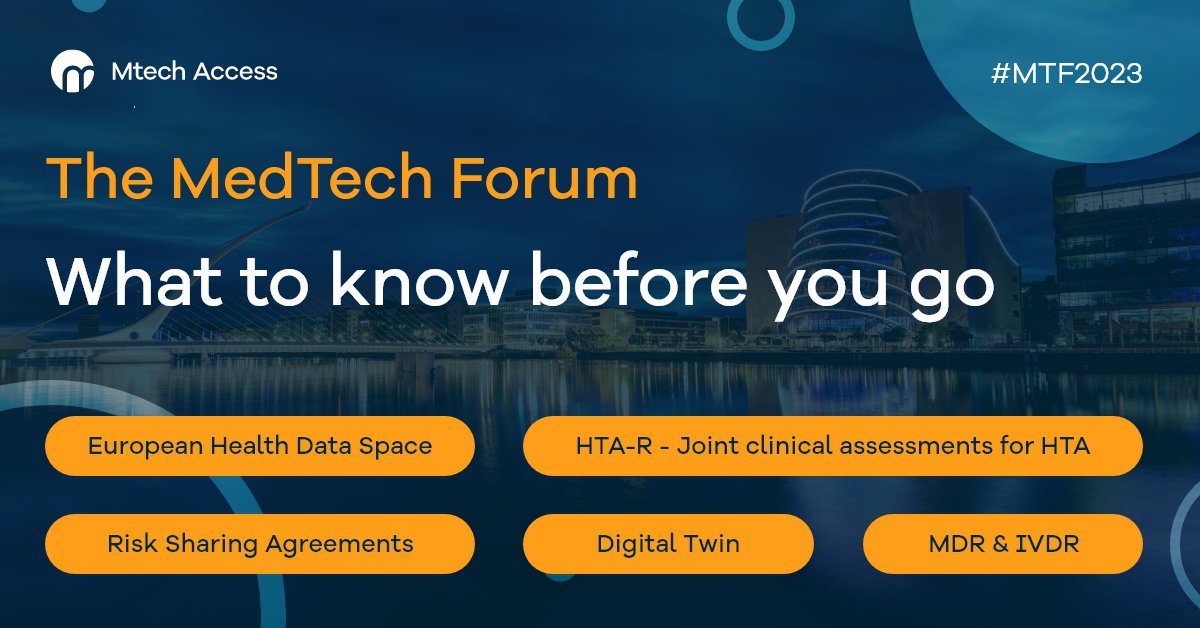
We are looking forward to attending the MedTech Forum in Dublin on 30th May–1st June 2023. The conference has a really exciting and varied programme, with sessions covering a variety of regulatory- and reimbursement-related topics, as well as industry trends and top innovations.
We have pulled together an overview of some of the key topics that will be explored:
- The potential of the EHDS
- HTA-R – Joint clinical assessments for HTA
- Risk Sharing Agreements for MedTech companies and payers
- Digital Twin technology in healthcare
- The latest on the MDR and IVDR
The EHDS
In May 2022, the European Commission published a proposition for the legislation termed the “European Health Data Space (EHDS)”. The objective of this legislation is to improve healthcare interoperability and patient empowerment over access, and to share their electronic health data at the European level.
The EHDS expands upon legislation such as the General Data Protection Regulation (GDPR), as well as other legislation including the Medical Devices and In Vitro Diagnostic Medical Devices Regulations (MDR; IVDR), the proposed Artificial Intelligence, proposed Data Governance Act and proposed Data Act, the Network of Information Systems Directive, and the Cross Border Healthcare (CBHC) Directive. Specifically, it will:
- Enable patients to have control over their own health data by allowing them to have free, improved access to data in an electronic form. The data can be easily shared with Healthcare Professionals (HCPs) in and across Member states to improve healthcare delivery
- Outline a common European format for patient summaries, e-prescriptions, images, image reports, laboratory results and discharge reports to support sharing and interoperability
- Ensure that EU citizens’ rights are safeguarded and that all Member states have an appointed digital health authority, whose responsibilities will include supporting cross-border digital infrastructure
- Provide a framework for access to large amounts of high-quality health data to support researchers, innovators, public institutions and industry in their research and development of life-saving treatments, as well as ensure better access to healthcare and build more resilient health systems
Together, the EHDS builds on the recognition that health data requires appropriate safeguarding, whilst aiming to enhance the availability of data to support research for much-needed innovation in the health sector.
Indeed, access to a larger body of real-world data in a common format by manufacturers and payers could pave the way for improved and faster development of treatments, as well as better our understanding of the patient pathway and burdens associated with diseases.
Discover more at:
- https://eur-lex.europa.eu/legal-content/EN/TXT/?uri=CELEX%3A52022PC0197
- https://ec.europa.eu/commission/presscorner/detail/en/ip_22_2711
- https://www.europarl.europa.eu/RegData/etudes/STUD/2022/740054/IPOL_STU(2022)740054_EN.pdf
HTA-R – Joint clinical assessments for HTA
Health Technology Assessment (HTA) procedures in the EU are traditionally carried out at a national level, resulting in different Member states asking manufacturers for different data simultaneously. In 2021, the EU introduced Regulation 2021/2283, creating instruments for standardising HTA across the Union. The aim of the regulation was to facilitate member states in assessing the effects of new health technologies and their pricing on health policies, whilst reducing the burden on companies. This was achieved by requiring one submission of the documentation only at the EU level, instead of multiple. The main objectives of the HTA Regulation (HTA-R) include:
- Attaining a high level of protection for patients and users whilst ensuring efficient operation of the internal market, including that for medical devices and in vitro diagnostics
- Ensuring central coordination of evaluating technologies for use, such as joint clinical analyses of data
- Applying uniform rules for HTAs
- Provision of an EU-funded foundation for common procedures
Whilst HTAs focus on the added value of a health technology in comparison with other new or existing technologies, in order to support price negotiation and reimbursement decisions, HTA-Rs cannot be disjointed from Medical Device Regulation (MDR). For MDR, assessments are often carried out on devices considered to be low risk (i.e. Class II/Class III).
Under the HTA-R, manufacturers may be required to deal with two HTA systems in the future, at both EU and national level. This may present a number of challenges:
- Requirements for clinical evidence may increase the time to market approval
- Whilst the HTA process may be centralised, each single Member state may wish to complement the HTA-R with additional data, which may lengthen the assessment process
- Coverage and reimbursement decisions will stay decentralised, which could further delay patient access in some Member states, particularly if the clinical evidence generated in the earlier stages of the approval process is not sufficient for the assessments made by HTA bodies
Despite this, the HTA-R provides an opportunity to standardise the HTA process at the EU level, in an ever complex environment to navigate. Changes are expected to be applicable from 12 January 2025.
The HTA-R is considered a step towards ensuring that appropriate evidence on the clinical effectiveness of innovative devices is delivered and that the transition between regulatory approval and coverage is conducted in a timely manner.
Discover more at:
- https://eur-lex.europa.eu/legal-content/EN/TXT/?uri=CELEX%3A52022PC0197
- https://www.johner-institute.com/articles/health-care/and-more/eu-hta-regulation-2021/2282-what-the-harmonized-health-technology-assessment-will-bring/
- https://eur-lex.europa.eu/legal-content/EN/TXT/?uri=CELEX%3A32021R2282
- https://health.ec.europa.eu/system/files/2022-06/hta_20220622_co03_en.pdf
Risk Sharing Agreements
Risk Sharing Agreements (RSAs) in healthcare are a tool used by health technology manufacturers with payers/health insurers to persuade them to take the risk on funding the new technology in the absence of a full data package.
Whilst RSAs have been widely implemented in the pharmaceutical sector, this is not the case for medical devices. Low evidence barriers to entry at the regulatory level allow new entrants to penetrate the market with similar products within a short span of a product launch. Meanwhile, there is a growing expectation for payers to reimburse devices based on superior clinical outcomes and cost-effectiveness. As such, there is a disconnect between ‘value’ and evidence demonstration for medical devices.
Payer-Manufacturer RSAs and innovative funding models have emerged in recent years in order to address payer concerns about the reimbursement of novel medical devices and technologies. These include:
Performance- / outcomes-based agreements
Examples of these include ‘coverage with evidence development’ and ‘performance-linked reimbursement’.
Coverage with evidence development addresses flaws or insufficiencies in the existing evidence package to support positive reimbursement. The product is reimbursed at a set price for a pre-determined period of time. The coverage decision is then made after the collection of additional evidence.
Performance-linked reimbursement is used when the payer is uncertain of the health benefits offered by the device. To mitigate this risk, the manufacturer agrees to provide rebates, refunds or price adjustments if the product fails to meet an agreed-upon outcome.
Financial-based agreements
Examples of financial-based agreements include risk sharing with mutual gains and subscription models.
With agreements based on risk sharing with mutual gains, the device manufacturer provides some financial advantage for the payer (e.g. offers a lower price versus alternatives). In return, the payer agrees to share an agreed percentage of the cost saving or revenue gain.
Subscription models can ease financial expenditure and support budgetary planning, particularly if the use of the technology is likely to be high. The manufacturer receives a fixed upfront payment regardless of usage in the healthcare system.
Value-based agreements
In value-based agreements, the manufacturer takes a holistic approach to measuring value around the care of each patient. Value is derived from measuring health outcomes against the cost of delivery.
There are a number of barriers to applying RSAs to medical devices, including changing payer perceptions and behaviours towards:
- Uncertainty around aligning contracting agreements with current tendering/procurement processes for medical devices
- Acceptance amongst payers that traditional funding mechanisms (e.g. bundled payments, DRG systems) are easier to manage and less complex than new funding models
- Difficulty in meeting payer evidence requirements, including collecting and using real-world data to support product performance and demonstrating added value versus more well-established devices and/or technologies
Consequently, manufacturers must continue to engage with payers and clinicians to build a business case for the value of a product; where payers require real-world evidence and outcomes data, manufacturers must ensure that this information can be easily tracked within healthcare systems. Manufacturers must demonstrate a clear benefit for payers to engage with RSAs, and ensure payer buy-in is supported by robust safety and efficiency data, leading to a situation that both parties view as beneficial.
Discover more at:
- https://www.insead.edu/sites/default/files/assets/dept/centres/hmi/docs/risksharingmedtech-insead-hmi.pdf
- https://www.ispor.org/docs/default-source/presentations/791.pdf?sfvrsn=e7ab6ac7_1
Digital Twin
A Digital Twin is described as ‘a virtual representation of physical assets, operational process, people or places’ and visualises complex assets and processes to improve performance. It has been used by many major companies to increase efficiency and spot problems, by combining the use of artificial intelligence, extended reality (XR), cloud, and internet of things (IoT).
In healthcare, Digital Twin technology can be used in a variety of ways, from digital representations of hospital environments to the modelling of patients’ medical conditions, vitals and outcomes, in order to develop more personalised and improved diagnosis and care plans.
For example, in the context of cardiac resynchronisation therapy, patients’ MRI, ECG and blood pressure may be leveraged to create a Digital Twin of their hearts. This helps cardiologists define the appropriate position of leads (due to variation between patients) and virtually experiment with the placement before interventional surgery.
Another opportunity with Digital Twin includes overcoming access challenges whilst ensuring treatments offer value and are costeffective. Indeed, payers are under increasing pressure to manage budgetary constraints, whilst ensuring continued access to innovative and promising technologies.
By expanding the IoT and the digitalisation of data, the Digital Twinning process can offer support to payers. It can result in better access to healthcare education, increased availability of self-healthcare management information, and improve access to healthcare services without restriction to geographical location.
Similarly, the implementation of a Digital Twin model of the healthcare environment offers the opportunity to identify resource constraints, allowing payers to plan accordingly, optimise patient pathways and support a more sustainable healthcare system in the future.
As a result, Digital Twins are seen as a technology that is able to alleviate some of the burdens placed upon payers – allowing payers to make data-driven decisions that optimise costs.
Discover more at
- https://www.apexon.com/blog/3-ways-digital-twins-improve-the-lives-of-healthcare-payers/
- https://www.mdpi.com/2504-2289/6/3/83/pdf
- https://www.einfochips.com/blog/digital-twin-top-use-cases-in-healthcare/#:~:text=By%20leveraging%20patients%20MRI%2C%20ECG,decision%20support%20for%20cancer%20treatment.
MDR and IVDR
The concept of CE marking under the Medical Device Regulation (MDR) is well established, both inside and outside the EU, to support medical device and in vitro device (IVD) regulation (IVDR).
CE marking is a requirement derived from the core legal framework of MDR and IVDR. It enables a device/IVD manufacturer to declare that their product has been assessed by appropriate means by the relevant conformity assessment bodies (notified bodies) and that it meets the regulatory standards relating to safety and efficacy. Affixation of a CE mark to a product means that it may be freely marketed anywhere in the European Economic Area (EEA) without further control.
However, despite the modernisation of the legislation in 2017, many stakeholders face challenges due to the significant changes in product development, data reporting and quality assurances that the MDR and IVDR demand.
As a result, device manufacturers are often left with high costs and extended timelines due to the barriers to access associated with clinical monitoring and evidence generation to certify (and recertify) new and existing products.
The main challenges include:
- Changes in the classification of devices: certain devices are considered to be in a higher risk class than previously (e.g. class II products that come into contact with the spinal cord are now considered class III). This increasing scrutiny based on risk leads to a possible need for costly recertification, and/or greater clinical evaluation before approval, resulting in slower time to market/device production. This will impact existing products too, as once their existing Medical Device Directive (MDD) certification expires, these products will need to be re-certified under the new rules
- Elevated clinical testing requirements: due to the reclassification of devices, manufacturers may be required to perform additional clinical testing. Manufacturers were not required to do so previously for IVDs, whilst device manufacturers must submit clinical data for reassessment if existing data does not meet new requirements. This adds to the increasing expense associated with maintaining legacy devices and also increases the cost barriers for new innovative products
- Increased demand on notified bodies: under the new MDR and IVDR legislation, notifying bodies are responsible for enforcing the new regulations, including all medical devices above Class I, and Class A for IVDs, which account for ~90% of all products. Together with increasing evidence scrutiny and minimum level of requirements, this will increase the notifying bodies’ workload
In order to overcome these challenges, early adoption of the new MDR and IVDR legislation is considered to be critical in ensuring success in the competitive market landscape. In particular, timely access to market and subsequent uptake by healthcare providers is crucial.
We hope to see you at The MedTech Forum – be sure to look out for our Mtech Access stand. For more tips on how to get the best out of the conference, check out our team’s top picks for sessions and pop by our virtual booth to check out our resources.


